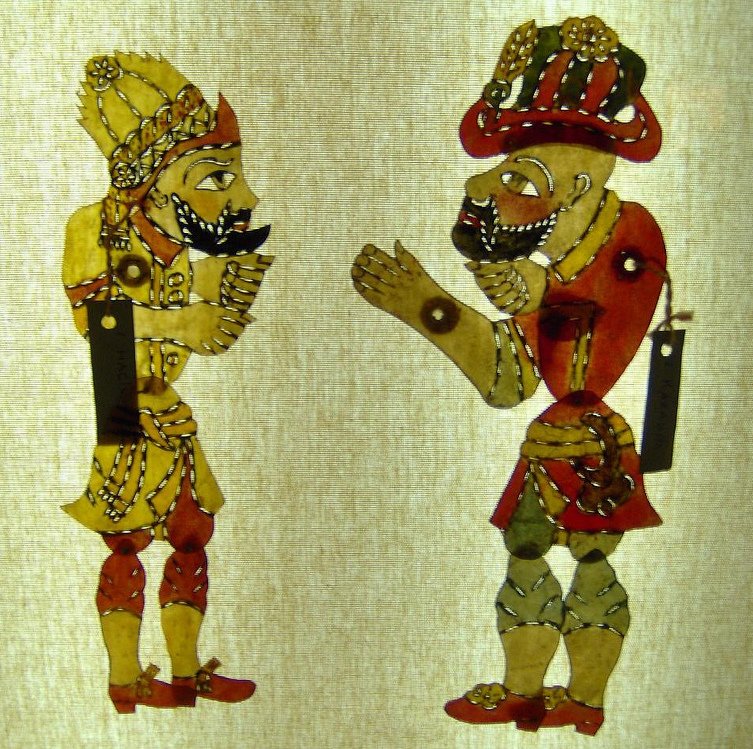Main Body
Chapter 1 Theater
Turkish Theatre Through the Ages: An Act in History
by Noah Bayindirli
Similar to the historical timelines in many countries, Turkish theatre arts plays a crucial role in the development of the nation itself. In the case of Turkey, the traditional aspects of this art form and its evolution over time are aesthetically dissimilar from that of European. As a consequence, Western readers need background information in order to fully understand Turkish theatre. At the same time, there are many commonalities, and the influence of European norms became stronger in the 19th century. This chapter approaches Turkish theatre chronologically, focusing on the early traditional forms, and ending with a discussion of the fusion of Turkish and European approaches. As we continue, we will discuss these varying techniques, as well as their origins and progression.
Turkish theatre provides a vast, colorful array of stages, characters, structures, and scripts. To begin, Ortaoyunu, otherwise known as “a play performed in the open,” sets the pace for some of the unique qualities of traditional Turkish theatre. Dating back to the thirteenth century, Ortaoyunu does not rely on written text and is typically staged within a circular arena, allowing for fluid interaction between the audience members and the actors themselves. Although preceded and ended with customary dances, it is this interaction that brings Ortaoyunu its improvisational structure, with a plot subject to dynamic interpretation.
Further distinguishing Ortaoyunu is a set of distinct characters, mainly Kavuklu and Pisekâr, known for their representation of the “common man” and a level-headed, charismatic conflict-mediator respectively, as well as a collection of character types used to represent varying facets of the population, including non-Muslims, entertainers, and supernatural beings.
Yet another form of traditional Turkish theatre is shadow puppetry. Shadow theater, or Karagöz, takes place on a stage composed of a muslin curtain surrounded by floral material, where the projections of puppets are manipulated to perform the story. The puppets are transparent, made from camel-hide- and vegetable pigment-composed figures. Traditionally, they would usually retell the tales of two misfit characters: Karagöz and Hacivad. Legend has it, while working on a mosque during the reign of the Ottoman empire in the capital of Bursa, the hijinks of these laborers proved so hilarious and distracting that the sultan had them executed in hopes to speed up the construction. Thus, these characters are memorials, who were supposed to have been created out of grief. The purpose of this characteristic form of traditional Turkish theatre was to preserve the spirit of Karagöz, known for his violent tendencies and uneducated yet witty outlook, and Hacivad, who, while intelligent, was no match for his friend’s antics.

Lastly, Meddah, or “Storyteller,” is a form of Turkish theatre presented by a single individual responsible for depicting the entirety of the play: stage, characters and all. Resembling that of a standup comedian, the Meddah describes settings relating to aspects of daily life, tales, or legends and digresses into laughable, literary, or even moral stories. Plays of this type were typically performed in the Ottoman Palace, on Ramadan nights or at circumcision celebrations.

While the traditional forms were responsible for a large segment of the history of theatre in Turkey, the Ottoman Empire’s adoption of Western ideals in the 19th century made room for event organizers to begin working with European companies. This movement caused tensions to rise between those who believed the traditional practices were dated or primitive and those appalled by this divergence. However, despite the controversy, Western influence began to take over, bringing with it multi-staged, subsidized theatres like the Darülbedayi-i Osmani Conservatoire of Istanbul and widely disparate themes, such as Shakespeare, social issues, and musicals. Following these changes, the Turkish scene expanded even further, incorporating private theatres to serve as the ground for younger, innovative playwrights to foster their new ideas and research—both political and economic—unregulated and censorship-free.
After decades of dramatic change within the Turkish theatre arts, Turkey now maintains an all-encapsulating display of modern, westernized theatre and traditional acting forms. Whether on the big stage for a musical in front of a dimly-lit audience or in a makeshift episode of Karagöz on a night of Ramadan, Turkish theatre continues to flourish for both old and new generations alike, bringing with it contemporary actors, researchers, and playwrights.
Works Cited
And, Metin. The Turkish Folk Theatre, Asian Folklore Studies. PDF, vol. 38, no. 2 (1979), pp.155-176, Nanzan University. JSTOR, www.jstor.org/stable/1177688. Accessed 31 Aug. 2017.
“Traditional Theatre, Ortaoyunu.” Turkish Cultural Foundation, www.turkishculture.org/performing-arts/theatre/traditional-theatre/traditional-theatre-ortaoyunu-288.htm?type=1. Accessed 30 Aug. 2017.
“Turkish Shadow Theatre – Karagoz and Hacivad.” Turkish Cultural Foundation, www.turkishculture.org/performing-arts/theatre/shadow-theatre/karagoz-and-hacivad-90.htm?type=1. Accessed 31 Aug. 2017.
“Meddah (Public Story Teller and Mimic).” Turkish Cultural Foundation, www.turkishculture.org/performing-arts/theatre/folk-plays/meddah-717.htm?type=1. Accessed 31 Aug. 2017.
Ekinci, Ekrem Bugra. “The art of the Meddah: Traditional Turkish storytelling.” DailySabah, 8 Apr. 2016, www.dailysabah.com/feature/2016/04/08/the-art-of-the-meddah-traditional-turkish-storytelling. Accessed 31 Aug. 2017.
“An Excursion in the Turkish Theatre.” Turkish Cultural Foundation, www.turkishculture.org/performing-arts/theatre/traditional-theatre/the-turkish-theater-590.htm?type=1. Accessed 1 Sept. 2017.
